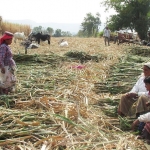S. Asia: Leaders Need Fresh Approach to End Hunger, Say Experts
Governments in South Asia are failing to make significant progress in reducing high levels of hunger in the region because they are not aware of the difficulties faced by farmers, a New Delhi-based campaigns group said Wednesday.
Some 400 million people in South Asia--which stretches from Pakistan across the Indian subcontinent to Sri Lanka and The Maldives--are malnourished or hungry because governments are not looking at the root of the problem, according to Gene Campaign, which conducts advocacy work on food security and farmers' rights.
"Nothing in Indian policy, or for that matter policy in South Asia, indicates that governments are addressing the issue of why hunger remains," said the Campaign's convener Suman Sahai. "Unless governments know what problems and challenges farmers face in the fields, hunger will continue to be a problem," she said.
Sahai's comments came in reaction to a report released Tuesday by the United Nations Food and Agriculture Organization which found that while the world's population would generally be better fed over the coming decades, hunger would continue to affect hundreds of millions of people even 25 years from now.
About 440 million of the world's projected 8.3 billion people in 2030 would go hungry, significantly less than the 777 million without food today. But the outlook for the next 30 years meant that the world would be a long way from achieving the pledge made at a 1996 world food summit to halve the number of hungry people by 2015.
"We need to augment investment in agricultural development and in particular in agricultural research - not only to raise yield levels, but also to maintain yield levels," said the report's author Jelle Bruinsma, noting that the task of halving hunger was "enormous."
"Those who are working in this field in India - where 250 to 300 million people go hungry every day - are not the least bit surprised to hear that hunger cannot be halved by 2015," said Sahai, citing, as an example, the northern Indian state of Uttar Pradesh where a decline in the yield of mustard seed crops, harvested for oil, had taken a toll on farmer's incomes and local food security.
"During a recent visit there I found that farmers no longer sow the seed because the oil content is lower than it used to be," she said. "Government researchers need to go to the fields to find out what happened to the crop. But nobody has done so," she said.
According to a recent survey conducted by The Right to Food Campaign, a nongovernmental group fighting hunger, villagers in the eastern Indian state of Jharkhand are drinking tea with salt to curb the pangs of hunger. "Others are soaking or boiling roots, and some are simply going without food for days," Jitendra Keswani of the Campaign told OneWorld.
Last month angry villagers from the drought-stricken state appealed to the government to deliver emergency food supplies that would help avert a hunger crisis. The state's chief minister, Babulal Marandi, arranged for three kilos of rice to be given to every family in the area each month.
But, said Keswani, the food package was "too little and too late."
- 181 Food and Agriculture



